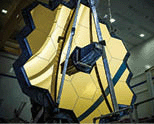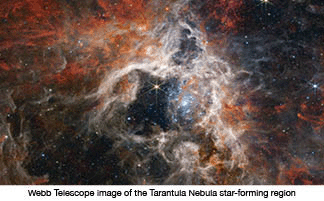Return to 2nd Quarter 2024 articles.

The James Webb space telescope is giving us new information about the construction and size of the cosmos. NASA continues to release discoveries that give us a better understanding of star and planet formation.
The recent Webb telescope data tells us what it takes to make a planet like Earth. The conventional understanding of planet formation is that as stars formed, they threw off material that gravity pulled together, forming planets. The Webb telescope has the resolving power and the infrared light-gathering ability to observe planet formation in different stages.

The first step in planet formation is for the star to actively produce elements a terrestrial planet requires. Quiet stars do not make the necessary elements since heavier elements will move toward the star's center, not outwards. The star must spin fast enough to throw out the required heavy materials. That means gaseous planets like Jupiter are much more common in the cosmos than terrestrial planets like Earth.
The heaviest elements in a planet come from exploding stars called supernovas. That means planets are more likely to be in certain types of galaxies, and galaxies have an evolutionary history, changing with time. The Webb telescope actually observes the changes in galaxies and star and planet formation. The creation process is still active, and new planets are being formed as we watch.

In manufacturing, we know that a machine is designed to take raw materials and mold and shape them into the desired final product. Years ago, I worked for a man who designed and built such machines, and his wisdom and creativity were incredible to watch. This designer did not use a blueprint or follow a manual. He had the skill to comprehend what the final machine would look like and what it would do.
We see God's wisdom and creativity as we watch star and planet formation. The writer of Proverbs wrote, “O you simple ones, understand prudence [wisdom], and you fools, be of an understanding heart” (Proverbs 8:5 NKJV). The Webb telescope allows us to see the wisdom of the Creator in ways we have never imagined.

Picture credits:
https://webbtelescope.org/contents/media/images/2022/052/01GF423GBQSK6ANC89NTFJW8VM
https://manoa.hawaii.edu/news/attachments/img11698_12192l.jpg
© krsmanovic/Bigstock.com
https://stsci-opo.org/STScI-01GA76RM0C11W977JRHGJ5J26X.png
Scripture links/references are from BibleGateway.com. Unhighlighted scriptures can be looked up at their website.
